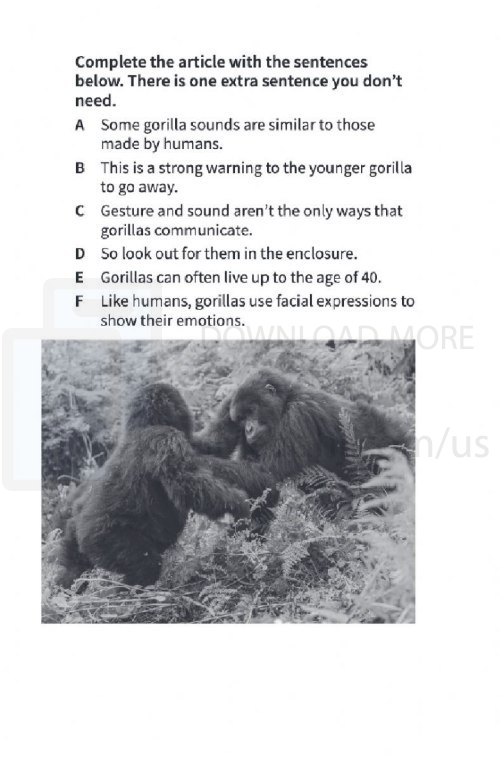| You are here: Almanahj Website ⇒ American curriculum ⇒ 6th Grade ⇒ Information and comm ⇒ Term 1 | ||
|---|---|---|
Gorilla information sheet Communication | ||
|---|---|---|
| Subject: Information and comm | ||
| 6th Grade | ||
| Term 1 | ||
| Year: 2023/2024 | ||
| Size: 352.3KB | ||
| Number of clicks: 94 | ||
| Publish date:November 12, 2023 | ||
| Added by: Eman | ||
| Last download date: 2024-09-11 15:59:19 | ||
| Updated by: Eman9966 on 2023-11-12 15:59:15 | By: theodor Micaela Fernandez | |
| File info: Gorillas are highly intelligent and social animals that use a variety of vocalizations, gestures, and expressions to communicate with each other. Vocalizations Gorillas have a rich repertoire of vocalizations, including grunts, barks, screams, and laughter. These vocalizations are used to express a variety of emotions, including fear, anger, contentment, and excitement. Grunts: Grunts are the most common type of vocalization used by gorillas. They are used to maintain contact with other gorillas, to warn of danger, and to express aggression. Barks: Barks are used to intimidate or scare off other gorillas. They are also used to attract attention, especially from mates. Screams: Screams are used to express fear or alarm. They are also used to signal danger to other gorillas. Laughter: Laughter is used to express contentment and happiness. It is also used to bond with other gorillas. Gestures Gorillas also use a variety of gestures to communicate with each other. These gestures include facial expressions, body postures, and hand signals. Facial expressions: Gorillas can make a variety of facial expressions, including smiles, frowns, and grimaces. These facial expressions are used to express a variety of emotions. Body postures: Gorillas use body postures to communicate with each other, such as hunching over to show submission or standing tall to show dominance. Hand signals: Gorillas use hand signals to communicate with each other, such as pointing to indicate food or reaching out to show affection. Expressions Gorillas also use a variety of expressions to communicate with each other. These expressions include eye contact, touch, and grooming. Eye contact: Eye contact is used to establish dominance or to express affection. Touch: Touch is used to express affection, to reassure a frightened gorilla, or to discipline a misbehaving gorilla. Grooming: Grooming is a social activity that helps to strengthen bonds between gorillas. It is also a way to remove parasites and dirt from the fur. In addition to vocalizations, gestures, and expressions, gorillas also communicate with each other through scent marking. Gorillas have scent glands on their chests, foreheads, and wrists. They use these glands to mark their territory and to attract mates. Gorilla communication is complex and nuanced. It is a vital part of their social lives and helps them to survive and thrive in their environment. Here are some additional facts about gorilla communication: Gorillas have been observed using sign language to communicate with humans. Gorilla infants learn to communicate by watching and interacting with their parents and other gorillas. Gorillas are able to learn new vocalizations and gestures throughout their lives. I hope this information is helpful. Please let me know if you have any other questions. | ||
| Downloading link Gorilla information sheet Communication |
|---|
|
1699799245.pdf
The file is being prepared for download
|
| File images |
|---|
 |